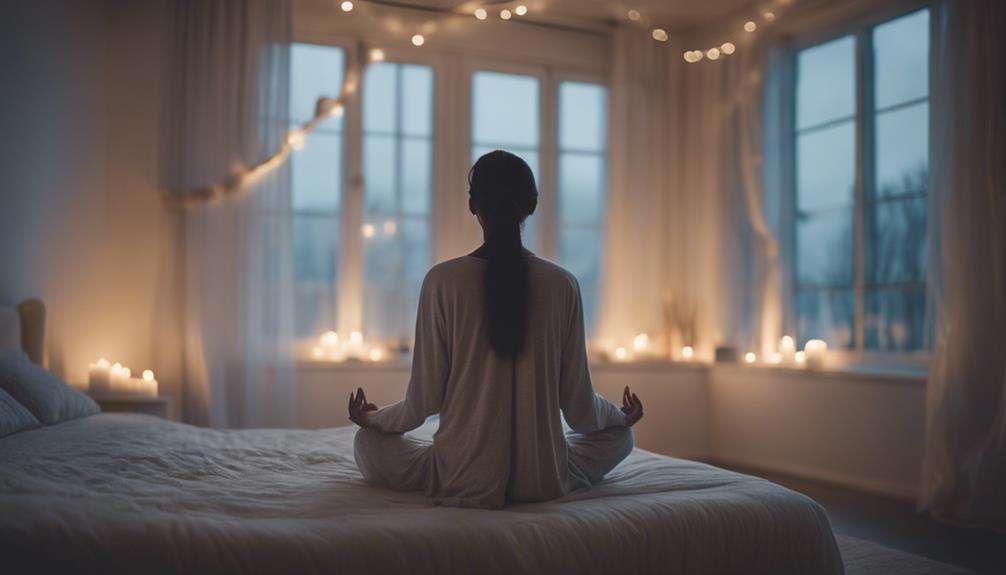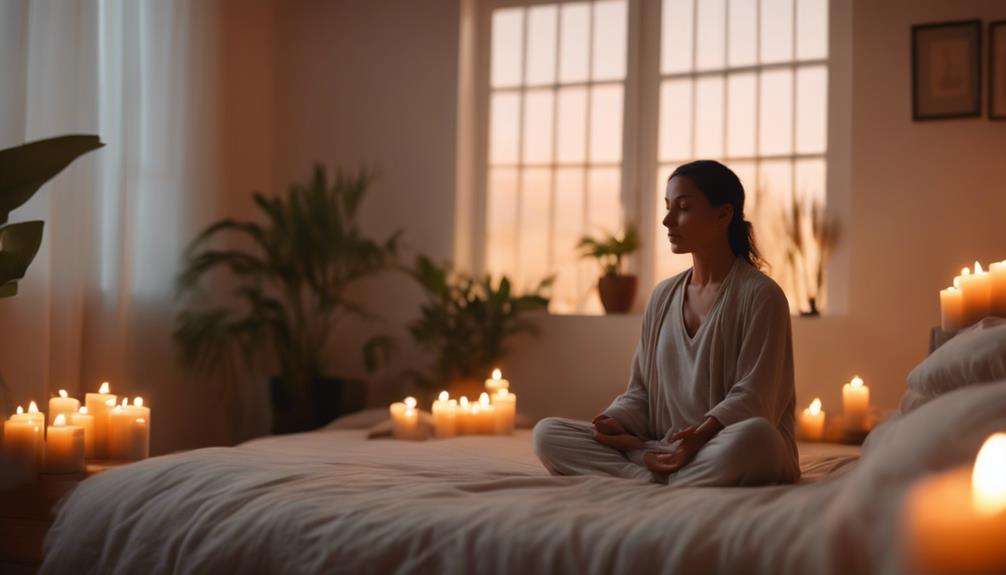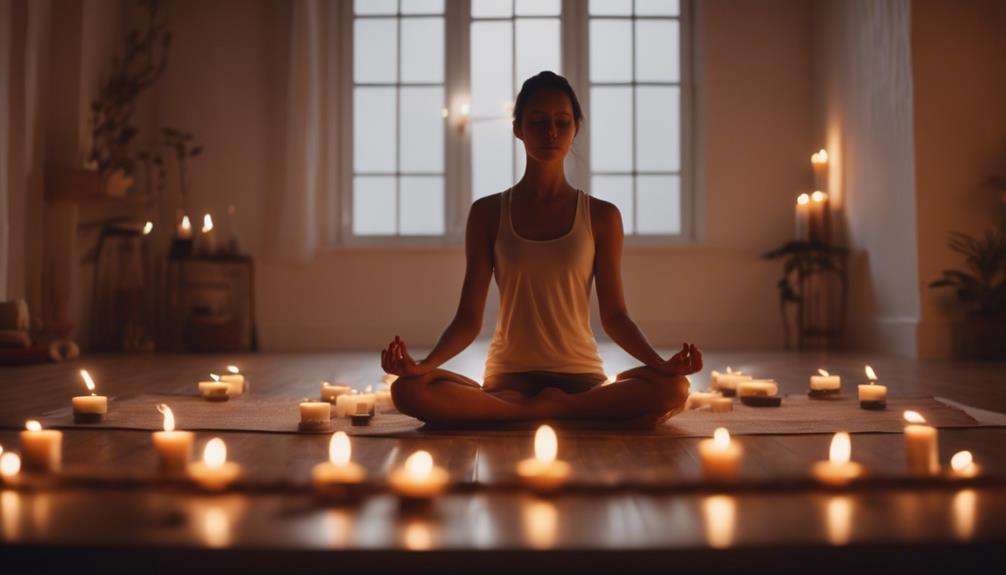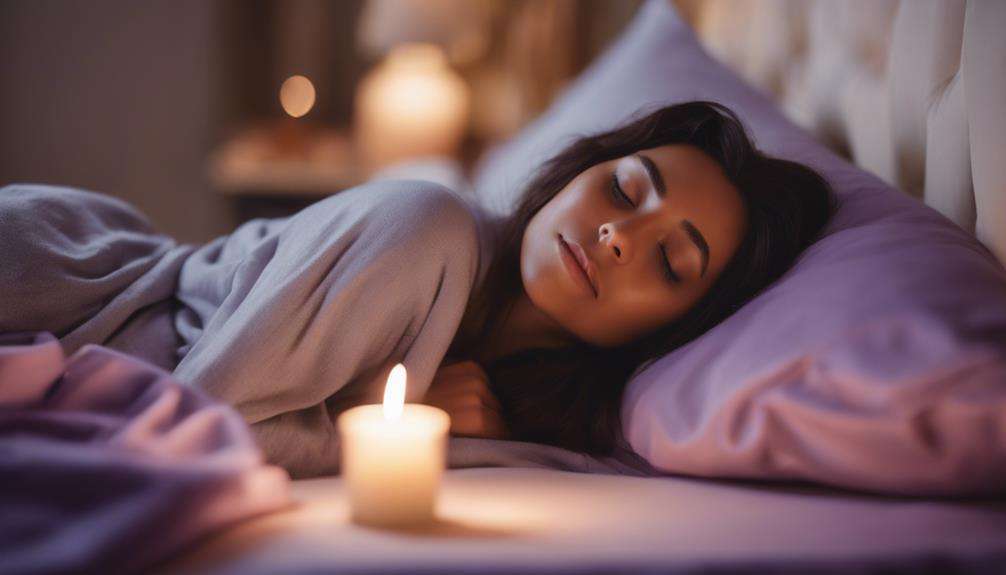Imagine your breath as the gentle waves of the ocean, rising and falling in a rhythmic pattern. Just as the ebb and flow of the tides soothe the shore, specific breathing techniques can lull your body and mind into a state of relaxation conducive to quality sleep.
Each breath holds the power to transform your sleep experience, but which techniques are most effective? Explore how different breathing practices can naturally enhance your sleep quality and lead you to a more restful night's rest.
Key Takeaways
- Belly breathing and Bhramari Pranayama induce relaxation and tranquility for improved sleep quality.
- The 4-7-8 breathing method and box breathing reduce anxiety and promote natural sleep.
- Alternate nostril breathing enhances cognitive function and overall sleep quality.
- Nasal breathing benefits include better airflow, focus, stress reduction, and preparation for restful sleep.
Belly Breathing Technique
To enhance your sleep quality naturally, consider incorporating the effective belly breathing technique into your bedtime routine.
Belly breathing, also known as diaphragmatic breathing, involves engaging the diaphragm muscle to take deep breaths that originate from the belly rather than the chest. This technique is crucial for stress reduction, as it promotes a more relaxed state by slowing down the breath and increasing oxygen flow throughout the body.
By incorporating belly breathing exercises into your nightly routine, you can create a natural pathway to relaxation, preparing your body for a restful night's sleep. This practice regulates the nervous system, signaling to your body that it's time to unwind and transition into a deep slumber.
The calming effect of belly breathing not only improves sleep quality but also fosters a sense of tranquility that carries into your waking hours, promoting overall well-being and mindfulness. Embrace the power of belly breathing as a simple yet potent tool for enhancing your sleep experience.
Bhramari Pranayama Breathing
When practicing Bhramari Pranayama Breathing, you can calm your mind by focusing on the humming sound produced. This technique is known to help relieve stress and anxiety, promoting a sense of relaxation.
Calms Mind With Sound
By incorporating Bhramari Pranayama breathing into your bedtime routine, you can effectively calm your mind with the soothing sound of humming. This ancient breathing technique aims to reduce stress and promote relaxation by focusing on the area between your eyebrows.
When practicing Bhramari Pranayama, the humming sound produced while exhaling through your nose helps create a sense of tranquility. Here are some key benefits of using Bhramari Pranayama for better sleep quality naturally:
- Reduces stress: The practice aids in lowering stress levels.
- Promotes relaxation: Helps in unwinding and preparing the mind and body for sleep.
- Enhances calmness: Encourages a peaceful state of mind.
- Diverts racing thoughts: The soothing sound shifts focus away from intrusive thoughts.
- Fosters tranquility: Creates a serene and tranquil mental space conducive to sleep.
Relieves Stress and Anxiety
Using Bhramari Pranayama breathing can effectively alleviate stress and anxiety by inducing relaxation through the gentle humming technique. This deep breathing method helps calm your mind by focusing attention between the eyebrows.
By engaging the parasympathetic nervous system, Bhramari Pranayama triggers the relaxation response, reducing anxiety levels. The act of covering the eyes and ears during this practice aids in stress relief, promoting a sense of calm.
Bhramari Pranayama is rooted in the yoga tradition of breath control and is known for its ability to enhance the quality of sleep by reducing stress and anxiety. Incorporating this technique into your routine can positively impact your overall well-being and help you achieve a more restful night's sleep.
Enhances Sleep Quality
Enhancing sleep quality can be achieved through the practice of Bhramari Pranayama breathing, a technique that involves covering your eyes and ears while humming to promote relaxation and calm the mind. By engaging in this yoga-based breath control practice before bedtime, you can help quiet your mind, fall into a deep sleep, and improve overall sleep quality naturally.
Here are some key points to emphasize the benefits of Bhramari Pranayama for enhancing sleep quality:
- Practice breathing exercises to relax the mind and body.
- Improve heart rate variability for better sleep.
- Engage in diaphragmatic breathing to promote deep relaxation.
- Use Bhramari Pranayama to prepare the body for restful sleep.
- Enhance sleep quality through the calming effects of this breathing technique.
4-7-8 Breathing Method
To delve into the -8 Breathing Method for better sleep, let's explore a technique that focuses on slowing down your breath to relax your mind and body. The 4-7-8 breathing method, which involves inhaling for 4 seconds, holding for 7 seconds, and exhaling for 8 seconds, is known to promote relaxation, improve sleep quality, reduce shallow breathing, calm the mind, and lower anxiety levels. By incorporating this technique into your bedtime routine, you can effectively manage insomnia and prepare your body for a restful night's sleep.
Regular practice of the 4-7-8 breathing method can train your body to relax more efficiently, leading to a natural improvement in sleep patterns. For enhanced benefits, consider pairing this breathing technique with soothing sounds or calming music to create a tranquil environment conducive to sleep. By integrating the 4-7-8 breathing method into your nightly routine, you can experience a more peaceful and rejuvenating sleep experience.
Box Breathing Exercise
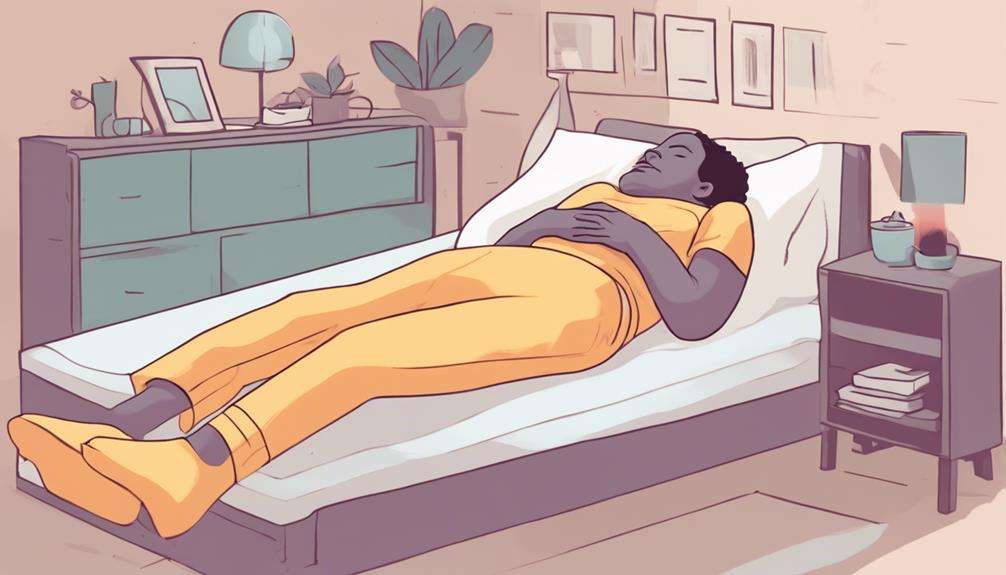
Box Breathing is a powerful technique that can significantly benefit your sleep quality. By following a structured breathing pattern, this exercise can calm your nervous system and promote relaxation naturally.
The upcoming discussion will cover the benefits of Box Breathing and provide steps to help you incorporate this technique into your bedtime routine effectively.
Benefits of Box Breathing
Utilizing the box breathing technique can have a significant impact on calming your nervous system, reducing stress, and enhancing your overall relaxation for improved sleep quality. Box breathing involves inhaling, holding, and exhaling in equal counts, which can lead to various benefits such as:
- Improving mental clarity and focus by regulating the breath
- Enhancing the ability to fall asleep by inducing calmness
- Supporting better sleep quality and a more restful night
- Deepening relaxation and enhancing the mind-body connection through visualization
- Acting as a natural sleep aid to promote a peaceful night's rest.
These benefits make box breathing a valuable tool in your sleep routine for achieving a restful and rejuvenating night's sleep.
Steps for Box Breathing
Transitioning from understanding the benefits of box breathing, let's now explore the practical steps involved in mastering this calming technique for better sleep.
Box Breathing is a simple yet effective exercise that can help reduce stress and anxiety by promoting a sense of calm in both the mind and body. To practice box breathing, start by inhaling deeply through your nose for 4 seconds, allowing your lungs to fill completely. Then, hold your breath for another 4 seconds.
Next, exhale slowly through your mouth for 4 seconds, ensuring a complete release of air. Finally, hold your breath again for 4 seconds before repeating the cycle. This rhythmic breathing pattern can enhance focus and concentration while also being a valuable addition to your bedtime routine, ultimately improving sleep quality.
Alternate Nostril Breathing Practice
To enhance your cognitive function and promote better airflow, consider incorporating the practice of Alternate Nostril Breathing into your daily routine. This natural breathing technique is known to improve sleep quality by preparing the body for relaxation and balancing the brain hemispheres. Here are some key benefits of incorporating Alternate Nostril Breathing into your daily routine:
- Balances the left and right brain hemispheres for improved cognitive function.
- Clears the nasal passages, promoting better airflow and oxygenation.
- Enhances focus and concentration by harmonizing energy flow in the body.
- Calms the mind, aiding in relaxation and stress reduction.
- Promotes overall well-being by preparing the body for restful sleep.
Guided Imagery for Sleep

Enhance your pre-sleep relaxation routine by incorporating guided imagery, a technique that combines calming visualizations with breathing exercises to promote better sleep quality.
Guided imagery involves selecting peaceful mental images while practicing diaphragmatic breathing, focusing on deep breaths that engage the diaphragm.
By utilizing videos or podcasts designed for guided imagery, you can enhance the relaxation experience and prepare your mind for a restful night's sleep.
Deepening this relaxation by engaging each of your five senses during the visualization process can further improve the quality of your sleep.
Integrating guided imagery into your bedtime routine can assist in reducing stress and promoting a restful night's sleep.
This practice not only helps in calming the mind but also sets the stage for a peaceful transition into sleep, making it a valuable tool in your quest for improved sleep quality through visualization techniques.
Integrating Breathing Exercises Into Bedtime
Integrating breathing exercises into your bedtime routine can significantly improve your sleep quality by signaling your body and mind to calm down and relax. To make the most of this practice, consider the following tips:
- Find a comfortable position: Ensure you're in a comfortable position, either lying down or seated, to fully relax your body.
- Focus on relaxed breathing: Pay attention to each inhale and exhale, allowing your breath to become deep and steady.
- Use a hand on the stomach: Placing a hand on your stomach can help you connect with your breath and promote a sense of calm.
- Combine with good sleep hygiene: Incorporating breathing exercises into your bedtime routine alongside good sleep hygiene habits can enhance the overall effectiveness.
- Individualized techniques: Explore various breathing exercises to find what works best for you, as personalized techniques can lead to improved sleep quality tailored to your needs. Remember, the goal is to calm down and center your mind before sleep.
Benefits of Yoga and Meditation for Wellness
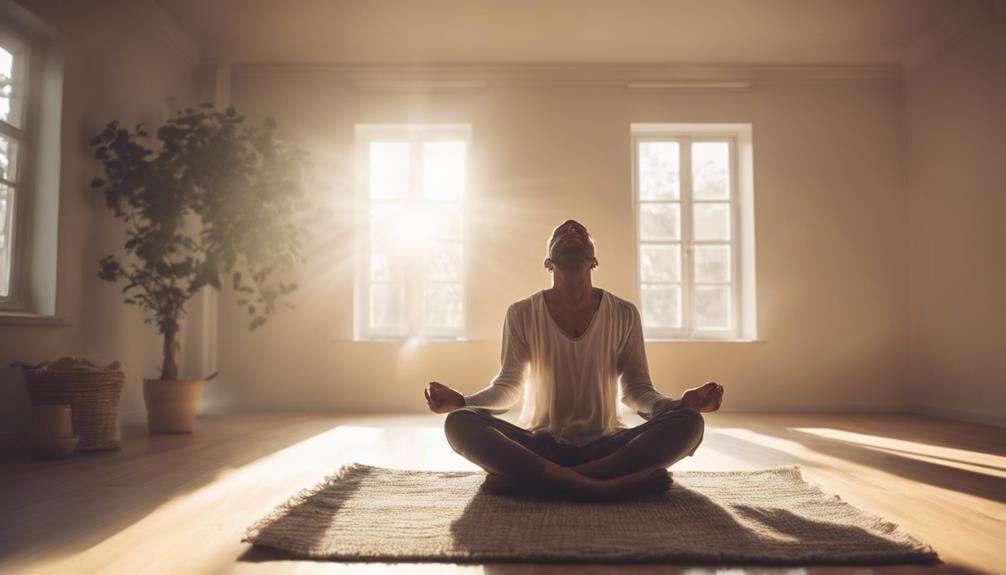
Explore the profound benefits of incorporating yoga and meditation practices into your routine for overall wellness and improved sleep quality. Yoga and meditation are known for their ability to reduce stress, enhance relaxation, and promote better sleep. Research has shown that regular practice of yogic breathing and mindfulness techniques can help regulate the nervous system, leading to improved sleep quality. By calming the mind and reducing insomnia symptoms, these practices can significantly enhance your overall well-being.
Moreover, incorporating yoga and meditation into your daily routine can result in decreased anxiety levels, improved mental clarity, and better emotional regulation. Mindfulness techniques practiced in yoga and meditation foster increased self-awareness, allowing you to manage your emotions more effectively. By engaging in these relaxation techniques, particularly before bedtime, you can create a peaceful state of mind that supports restful sleep. Embrace the power of yoga and meditation to not only reduce stress but also to improve your sleep patterns and emotional well-being.
Recommendations for Better Sleep Quality
For better sleep quality, consider incorporating specific breathing techniques that have been shown to promote relaxation and improve overall restfulness.
- Belly breathing: Encourages slower, relaxed breaths, engages the diaphragm muscle, and improves oxygen flow in the body for better sleep quality.
- Bhramari Pranayama: Aids in relaxation by covering eyes and ears while humming, focusing attention between eyebrows to promote sleep.
- 4-7-8 breathing technique: Reduces anxiety, promotes relaxation, and improves sleep quality with a specific pattern of inhaling, holding, and exhaling.
- Box breathing: Combines breathing exercises with visualization, calming the mind and body to enhance focus, concentration, and ultimately improve sleep.
- Alternate nostril breathing: Balances energy flow, clears the mind, improves lung function, and promotes relaxation and stress relief for better sleep preparation.
Incorporating these techniques into your bedtime routine can help calm the mind, reduce anxiety, and prepare your body for a restful night's sleep. Explore these breathing methods to find the one that best suits your needs and enhances your sleep quality naturally.
Frequently Asked Questions
What Is the Best Breathing Technique to Help You Sleep?
To sleep better, try diaphragmatic breathing for relaxation. Focus on belly breaths, engage in mindful breathing, and use slow exhales for sleep induction. These techniques enhance sleep hygiene, aid relaxation, and improve sleep quality naturally.
Does Deep Breathing Improve Sleep Quality?
To enhance your sleep quality, deep breathing triggers your body's relaxation response, regulating your respiratory rate and calming your mind. This practice can improve sleep hygiene, reduce stress, and promote a healthier mind-body connection naturally.
What Helps You Breathe Better at Night?
To breathe better at night, focus on nasal breathing, relaxation techniques, and mindful breathing. Incorporate breathing exercises into your nighttime routine for improved sleep quality. Pay attention to your sleep hygiene, use diaphragmatic breathing, and try a body scan.
What Is the 4 7 8 Breathing Method for Sleep?
The 4-7-8 breathing method is a powerful relaxation technique. It promotes a mind-body connection, reduces stress and anxiety, aids sleep, and enhances deep relaxation. Incorporate this calming breath into your bedtime routine for improved sleep hygiene.
Conclusion
Congratulations on mastering these breathing techniques to improve your sleep naturally!
Now, as you lay down to rest, picture yourself peacefully drifting off to dreamland…
But wait, don't forget to breathe in for 4, hold for 7, and exhale for 8.
Sweet dreams await as you embrace the power of your breath to guide you into a night of deep, rejuvenating sleep.
Goodnight, sleep tight, and breathe right!

